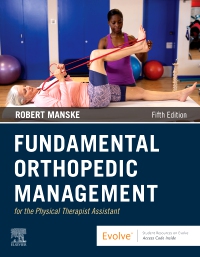
Fundamental Orthopedic Management for the Physical Therapist Assistant - Elsevier eBook on VitalSource, 5th Edition
Elsevier eBook on VitalSource

Now $58.58
Master the PTA’s role in orthopedic care — from the examination to treatment planning and interventions! Fundamental Orthopedic Management for the Physical Therapist Assistant, 5th Edition helps you understand and apply the principles of orthopedic science to clinical practice. First you will learn the basics of assessing flexibility, strength, endurance, and balance, and then you’ll become a more valuable PTA by learning the essentials of tissue healing, gait and movement, kinesiology, and the management of orthopedic patients by region and condition. This edition reflects the latest, evidence-based practice and adds updates to the Evolve website. Written by clinician and educator Robert Manske, along with a team of expert contributors, this book describes how to work effectively with a supervising physical therapist!
-
- Comprehensive coverage addresses not only core concepts related to orthopedic care, but also includes biomechanics, pharmacology, imaging, in-depth reviews of the types of tissue healing, and the PTA's role in physical assessment and interventions.
- More than 600 illustrations and 75 summary tables reinforce orthopedic concepts and procedures.
- A focus on critical thinking and application prepares you for the treatment room and for the clinical practicum portions of your PTA program.
- Important Concepts highlight useful tips to remember in patient practice.
- Key terms and learning objectives begin each chapter, serving as checkpoints for understanding and helping you study effectively for examinations.
- Review questions at the end of each chapter prepare you for the kind of critical thinking you will be required to do in practice.
- Glossaries in each chapter make it easy to find definitions of key terminology.
- Useful appendices provide a quick reference to information such as commonly used medications, fracture eponyms, and reference ranges for lab tests.
-
- NEW! Updated content and references are added throughout the book to reflect changes in practice patterns.
- NEW! Expanded full-color illustrations add clarity to anatomy and procedural drawings and make it easier to learn important concepts
- NEW! Updated chapter summaries highlight essential, need-to-know information.
- NEW! Updated educator and student resources on the Evolve website provide tools to make teaching and learning easier.
-
PART I: BASIC CONCEPTS OF ORTHOPEDIC MANAGEMENT
1. Patient Supervision and Observation During Treatment
2. The Role of the Physical Therapist Assistant in Physical Assessment
3. Differential Diagnosis and Emergent Conditions
4. Muscle Flexibility and Range of Motion
5. Muscle Strength
6. Endurance
7. Balance and Coordination
PART II: REVIEW OF TISSUE HEALING
8. Composition and Function of Connective Tissue
9. Ligament Healing
10. Bone Healing
11. Cartilage Healing
12. Muscle and Tendon Healing
13. Neurovascular Healing and Thromboembolic Disease
PART III: BASIS FOR MOVEMENT
14. Fundamentals of Normal and Abnormal Gait
15. Concepts of Joint and Soft Tissue Mobilization
16. Biomechanics and Kinesiology
PART IV: MANAGEMENT OF ORTHOPEDIC PATIENTS BY REGION
17. Orthopedic Management of the Ankle, Foot, and Toes
18. Orthopedic Management of the Knee
19. Orthopedic Management of the Hip and Pelvis
20. Orthopedic Management of the Lumbar, Thoracic, and Cervical Spine
21. Orthopedic Management of the Shoulder
22. Orthopedic Management of the Elbow
23. Orthopedic Management of the Wrist and Hand
PART V: MANAGEMENT OF ORTHOPEDIC PATIENTS BY CONDITION
24. Orthopedic Management of Rheumatic Disorders
25. Orthopedic Management of Pain and Pain Syndromes
26. Orthopedic Management of Orthotics and Prosthetics
27. Musculoskeletal-Related Dysfunctions of the Pelvic Floor
PART VI: TOPICS IN ORTHOPEDICS
28. Concepts of Orthopedic Pharmacology
29. Imaging for the Physical Therapist Assistant
Appendix A: Commonly Used Medications in Orthopedics
Appendix B: Reference Ranges for Commonly Used Tests
Appendix C: Units of Measurement and Terminology for the Description of Exercise and Sport Performance
Appendix D: Fracture Eponyms
Appendix E: Major Movements of the Body and the Muscles Acting on the Joints Causing the Movement


 as described in our
as described in our 